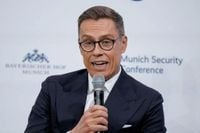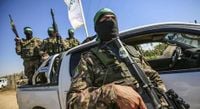European leaders are intensifying discussions regarding the potential deployment of troops to Ukraine, but this move hinges on specific conditions that must be met first. According to Admiral Rob Bauer, the head of the NATO Military Committee, there are three critical requirements that need to be fulfilled before any troops can be sent. First and foremost, there must be an absolute cessation of hostilities, which both sides must adhere to. Secondly, a strong mandate under the auspices of the United Nations is essential. Finally, the force deployed should be authoritative and multinational, comprising not just European soldiers but a diverse array of troops capable of ensuring safety in the region.
These discussions come as the conflict in Ukraine continues to evolve, with significant military and political implications. Admiral Bauer emphasized that the primary guarantee of security for Ukraine lies within its own Armed Forces. Over the past three years of conflict, the resilience of these forces, bolstered by international support, has led to a notable increase in their effectiveness. This ongoing assistance includes weapon supplies, training, and enhanced cooperation with allied nations, all aimed at restoring Ukraine's military capabilities and reorganizing its defense forces to deter further aggression.
In a related context, Finnish President Alexander Stubb has outlined a phased approach to introducing peacekeepers in Ukraine. He articulated that the first phase involves achieving a ceasefire, followed by the establishment of a de facto peace agreement. President Stubb highlighted the importance of providing specific security guarantees as a priority during this initial stage. He stated, "This means you can assist in the air, at sea, possibly on land. This is the kind of planning our military is currently engaged in. The political decisions we are making here in Paris are part of this first stage."
Stubb also delineated the second phase, which focuses on supporting and agreeing to peace. This phase would involve deploying troops to manage crisis situations or peacekeeping forces based on an international mandate. He clarified that while a ceasefire indicates a cessation of war, a peace agreement signifies the beginning of peace. This distinction is crucial as the international community seeks to stabilize the region.
French President Emmanuel Macron is also considering the deployment of a peacekeeping contingent to central Ukraine, potentially positioning these foreign forces along the Dnieper River, far from the front lines of conflict. This proposal underscores the growing urgency among European leaders to establish a framework for peace in Ukraine while ensuring that any military presence is robust and well-supported.
Moreover, Admiral Bauer stressed the necessity for a sustainable peace following the conflict, warning against the pitfalls of a scenario reminiscent of previous agreements like "Minsk-3." He asserted, "Russia should not use the truce to regroup and should never try to seize even one square centimeter of Ukrainian land." This sentiment reflects a broader consensus among NATO allies on the importance of preventing any resurgence of hostilities once a ceasefire is achieved.
The discussions surrounding troop deployment and peacekeeping efforts have gained momentum following the third summit of the "coalition of the willing," held in Paris on March 27, 2025. This new format, initiated by Britain and France, aims to galvanize support for Ukraine amid ongoing challenges. The summit served as a platform for leaders to share their perspectives on the evolving situation and to strategize collective action.
As the situation unfolds, the international community remains watchful, recognizing that the path to peace in Ukraine is fraught with complexities. The delicate balance between military readiness and diplomatic efforts will be pivotal in shaping the future of the region. With European leaders united in their commitment to support Ukraine, the emphasis will be on ensuring that any military intervention is accompanied by a clear mandate and a commitment to long-term stability.
In conclusion, the discussions surrounding the deployment of troops to Ukraine reflect a critical moment in the ongoing conflict. With conditions set forth by NATO and European leaders, the focus now shifts to achieving a sustainable ceasefire and fostering an environment conducive to lasting peace. The stakes are high, not only for Ukraine but for the broader security of Europe and the world.






